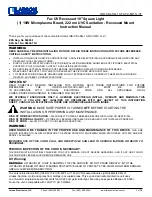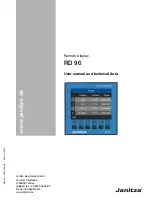
1.0 Executive Summary
This white paper compares the safety and germicidal effectiveness of 222 nm and 254 nm
ultraviolet (UV) wavelengths when applied to sanitation. An overview UV-C sanitation is
provided to establish the mechanisms of disinfection with UV light. Next, the properties of both
UV-C bands are showcased in order to highlight their unique characteristics and various
associated safety precautions. Artificial light sources capable of emitting these types of UV-C
light are carefully assessed to determine the practicality of deployment based on technological
limitations and environmental factors (temperature, humidity, etc.). The white paper concludes
with recommendations on how to best leverage far-UV 222 nm and 254 nm for sanitation
purposes in industrial and commercial sites.
Larson Electronics is a manufacturer of industrial lighting systems, explosion proof devices and
power distribution products. The company has more than 40 years of experience in the
industrial sector, serving a wide range of organizations and businesses. This paper supports the
use and effectiveness of 222 nm and 254 nm UV lights for germicidal applications.
2.0 Introduction
According to data from the International Ultraviolet Association (IUVA)
1
, UV treatment has
been around for more than 40 years. As a tried-and-tested solution, UV disinfection is prevalent
in hospitals, medical or healthcare centers, laboratories, food processing, wastewater facilities,
HVAC system management and more. At 2018, the UV disinfection equipment market was
valued at $1.1 billion by Allied Market Research. This industry is forecasted to reach $3.4 billion
by 2026 (or at a compound annual rate of 15 percent from 2019 to 2026).
UV light contains several unique properties and characteristics, which can be used to disinfect
up to 99.9% of viruses, bacteria, mold, spores and other harmful microbes. According to experts
from University of British Columbia, University of Alberta, University of Colorado-Boulder and
Trojan Technologies
2
, UV-C light is capable of killing tuberculosis,
e.coli
,
methicillin-resistant S.
aureus
(MRSA) and more. Initially, this sanitation method relied on the UV-C spectrum, i.e. UV-
C rays within the range of 200 nm to 280 nm (traditionally optimized at 254 nm), to deactivate
the cellular ribonucleic acid (RNA) and deoxyribonucleic acid (DNA), as well as the reproductive
capabilities of microorganisms. Although highly effective in eliminating microbes on surfaces
and in the air, the 254 nm UV-C band is dangerous to humans. Extended exposure to this UV-C
wavelength, typically using fluorescent UV lamps, can cause mild to severe sunburns and
temporary to permanent vision loss without proper safety gear.
Advancements in UV light technology addresses the drawbacks and limitations of traditional
UV-C sanitation using 254 nm bands by introducing far-UV sanitation lights to the market. This
type of germicidal lamp utilizes 222 nm UV rays to eliminate bacteria, viruses, mold, spores,

































